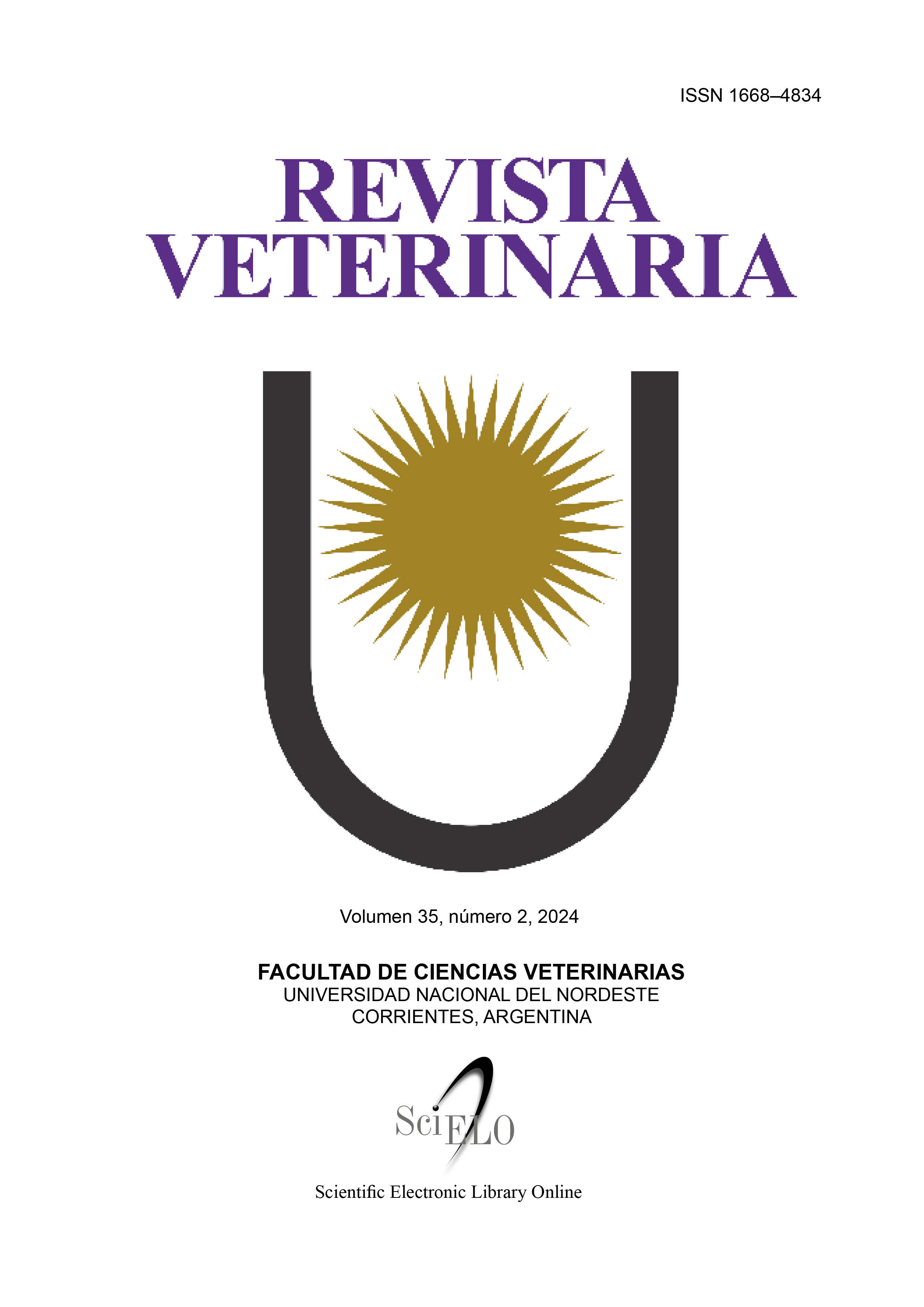Hypovitaminosis A in two beef calves
case report in Buenos Aires province
DOI:
https://doi.org/10.30972/vet.3527872Keywords:
Vitamin A, Deficiency, Blindness, CattleAbstract
Hypovitaminosis A is an uncommon disease in grazing livestock systems, as the primary source of precursors (carotenes) is fresh forage. However, under environmental circumstances predisposing to the development of poor-quality forage, vitamin A deficiency and associated clinical signs can occur. This article describes the clinical findings of hypovitaminosis A in two 2-months-old calves in beef herd in Ayacucho, Buenos Aires Province, in November 2023. Blindness was the only clinical sign observed in a beef herd.. Low vitamin A concentration was detected in blood of affected and non-affected calves and their mothers ranging from 7.8 to 24.8 μg dL-1 in calves and from 15.5 to 28.9 μg dL-1 in cows (reference 25-35 μg dL-1 in calves and 40-50 μg dL-1 in adults), confirming the deficiency status of the herd. During gestation, dams were fed corn-harvested hay. This diet may have been a poor source of carotene, leading to reduced hepatic reserves of vitamin A in the calves at birth. Consequently, clinical signs may have occurred during the first few weeks when these reserves were depleted.
Downloads
References
Craig L, Dittmer K, Thompson K. Bones and joints. In: Maxie M, editor. Jubb, Kennedy, and Palmer’s Pathology of Domestic Animals. Vol. 1. 6th ed. Elsevier, St. Louis, US; 2016. p. 82-4.
Donkersgoed J, Clark E. Blindness caused by hypovitaminosis A in feedlot cattle. Can. Vet. J. 1988; 29: 925-7.
Ghaffari M, Bernhöft K, Etheve S, Immig I, Hölker M, Sauerwein H, Schweigert F. Technical note: rapid field test for the quantification of vitamin E, β-carotene, and vitamin A in whole blood and plasma of dairy cattle. J. Dairy Sci. 2019; 102: 11744-50.
Hill B, Holroyd R, Sullivan M. Clinical and pathological findings associated with congenital hypovitaminosis A in extensively grazed beef cattle. Aust. Vet. J. 2009; 87: 94-8.
Kang S, Park C, Seo K. Ocular abnormalities associated with hypovitaminosis A in Hanwoo calves: a report of two cases. J. Vet. Med. Sci. 2017; 79: 1753-6.
McGill J, Kelly S, Guerra-Maupome M, Winkley E, Henningson J, Narasimhan B, Sacco R. Vitamin A deficiency impairs the immune response to intranasal vaccination and RSV infection in neonatal calves. Scient. Rep. 2019; 9: 15157.
Mason C, Buxton D, Gartside J. Congenital ocular abnormalities in calves associated with maternal hypovitaminosis A. Vet. Rec. 2003; 153: 213-4.
Millemann Y, Benoit-Valiergue H, Bonnin J, Fontaine J, Maillard R. Ocular and cardiac malformations associated with maternal hypovitaminosis A in cattle. Vet. Rec. 2007; 160: 441-3.
Parker E, Gardiner C, Kessell A, Parker A. Hypovitaminosis A in extensively grazed beef cattle. Aust. Vet. J. 2017; 95: 80-4.
Pickworth C, Loerch S, Kopec R, Schwartz S, Fluharty F. Concentration of pro-vitamin A carotenoids in common beef cattle feedstuffs. J. Anim. Sci. 2012; 90: 1553-61.
Sosa E, Morrell E, Llada I, Odriozola E, Cantón G. Congenital hypovitaminosis A in dairy cattle. Vet. Rec. Case Rep. 2024; 12: e744.
Swanson K, Merchen N, Erdman J Jr, Drackley J, Orias F, Morin D, Haddad M. Influence of dietary vitamin A content on serum and liver vitamin A concentrations and health in preruminant Holstein calves fed milk replacer. J. Dairy Sci. 2000; 83: 2027-36.
Takahashi N, Naoshi K, Watanabe O, Fukushima M, Iwaki F, Quoc Tuan N, Yoshida K, Shiigi T, Ogawa Y, Fukuzono K, Nakano M. Effects of serum vitamin A level on tapetum in Japanese Black cattle eye. EAEF. 2011; 4; 126-30.
Van der Lugt J, Prozesky L. The pathology of blindness in new-born calves caused by hypovitaminosis A. Onderstepoort J. Vet. Res. 1989; 56: 99-109.
Downloads
Published
How to Cite
Issue
Section
License

This work is licensed under a Creative Commons Attribution-NonCommercial 4.0 International License.
Revista Veterinaria (Rev. Vet.) maintains a commitment to the policies of Open Access to scientific information, as it considers that both scientific publications as well as research investigations funded by public resources should circulate freely without restrictions. Revista Veterinaria (Rev. Vet.) ratifies the Open Access model in which scientific publications are made freely available at no cost online.











.jpg)
.jpg)



